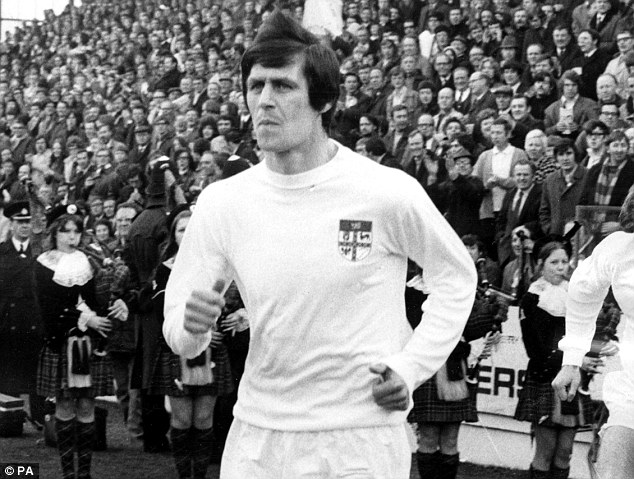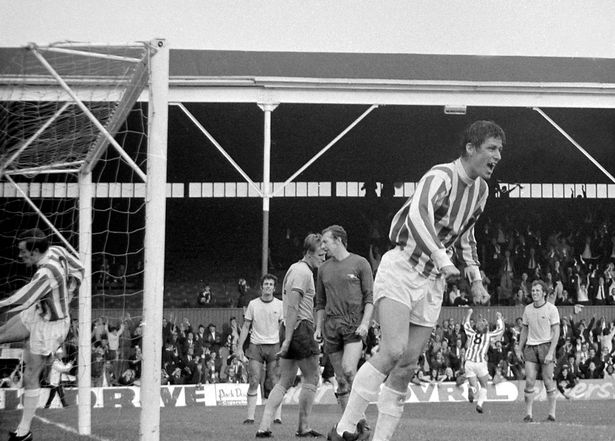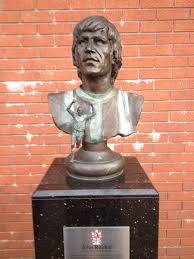On Saturday April 13th, 1963, a young centre forward sat in the home dressing room deep within the bowls of the Victoria Ground, the home of Stoke City. The Potters, under the managerial genius of Tony Waddington, were well on their way to winning the Second Division title and there was a genuine air of excitement across the region among supporters, with the prospect of returning to the top flight of English football became a genuine possibility.
The youngster sat with terrified look across his face having just been informed that he would be making his Stoke City debut within the next hour. It would be his first appearance as a professional in the Football League, having joined the club a year earlier from Kettering Town, whilst he also had the task of filling in for The Potters’ leading goal scorer that season, Dennis Viollet, who was missing the match due to injury.
Moral support came from legendary Stoke City figure Stanley Matthews who, now into his late 40s, had returned to his hometown club for a second stint after a spell with Blackpool. Having noticed the youngster’s apprehension, the veteran put a reassuring arm around the centre forward’s shoulder and said:
“These people are just waiting for a hero to come along. They need a hero. They need a centre-forward that can score goals and you can be that man. If you can do that for them, they’ll never forget you.” [1]
The youngster went by the name of John Ritchie – he was about to embark on a career that would make him Stoke City’s all-time leading goal scorer.
These people are just waiting for a hero …
John Ritchie was born on July 12th, 1941, and he initially rose to prominence as a teenager with Kettering Town who competed in the Southern League. He was a tall, imposing and physical centre forward who was also deceptively quick and enjoyed a clinical instinct in front of goal despite his tender years. [2] However, Kettering Town were far from being a prestigious club and did not possess the financial capacity to award players full-time contracts, something that resulted in the club being rejected from joining the Football League for four consecutive years between 1957 and 1961. As such, Ritchie was classed as a part-time professional and he had to complement his income earned through football by working for a local shoe factory. [3]
The centre forward’s arrival at Stoke City was characterised by a mixture of luck, circumstance and speculation.
Tony Waddington had been appointed as first-team manager at the Victoria Ground in 1960 and he was renowned for his meticulous approach when signing new players, always ensuring that he personally scouted potential transfer targets. However, he signed Ritchie without having seen him play after becoming aware of the teenager from a fellow manager. Arthur Turner, then in charge of Headington (modern-day Oxford United), had attempted to purchase Ritchie at the start of the summer of 1962 but had been left frustrated by his chairman’s unwillingness to meet Kettering Town’s £2,500 asking price. Waddington, hearing of Turner’s interest in the youngster, and undoubtedly impressed by the fact that the centre forward had scored 30 goals during the 1961/62 season, decided to gamble, [4] later admitting:
“I knew Arthur [Turner] was a good judge of player and for £2,500 it was worth taking a chance … I went to Kettering and signed John Ritchie without ever seeing him play.” [5]
It also transpired that Northampton Town had been keen to sign Ritchie and had been willing to meet Kettering Town’s asking price. However, Dave Bowen, the Cobblers’ manager, had gone on holiday before any formal agreement was made and his absence allowed Stoke City to slip in and sign the youngster. [6]
Waddington’s blind gamble would ultimately become one of the most significant signings in Stoke City’s history.
Having signed for The Potters in June 1962, Ritchie initially struggled to make any significant impact at the Victoria Ground. He made his debut for the first team in a League Cup tie against Walsall in September 1962 and did not make his Football League debut until the contest against Cardiff in April 1963, [7] where Stanley Matthews had explained to him prior to kick off that the Stoke City supporters “need a hero … and you could be that man”. [8] Ritchie made only a scattering of sporadic appearances during his first season in The Potteries (1962/63) and failed to score for the senior team, having to be content with a place in the reserve side as the club secured the Second Division title. The centre forward later admitted that he had been “worried about his future” and that Waddington had asked him “to be patient and wait for the chance that was bound to come”. [9]
That opportunity occurred at the start of the 1963/64 season when several injuries to forward players provided a gap in the starting eleven. Ritchie quickly capitalised and his first senior goal for the club against Bolton Wanderers in October 1963 sparked an incredible run of form in which he scored 15 goals in nine successive league and cup fixtures. [10] The Daily Mirror lauded the 22-year-old as the next goal scoring sensation in English football and remarked on his sudden rise to fame by noting that he “was unknown less than three months ago”. [11] Ritchie ended the 1963/64 season with 28 goals in total and netted 10 times in the League Cup, a record that has only been surpassed by two players in the competition’s history. [12]
The youngster quickly demonstrated that his breakout season had been no fluke and he scored 30 goals and 29 goals in the 1964/65 and 1965/66 season respectively. [13] The press stated that Ritchie had overtaken the likes of Stanley Matthews, Jimmy McIlroy and Peter Dobing to take the “number one spot … in Stoke City fans’ hit parade”. [14] Furthermore, there was a growing clamour for the centre forward to be included in the England’s 1966 World Cup squad whilst it was suggested that “it looked to be no limit to what he could achieve in the game”. [15]

Disaster and departure
In under three years John Ritchie had gone from being an unknown youngster to one of the leading goal scorers in the country who was now in contention to play at the forthcoming World Cup. However, in September 1964 disaster struck.
During a mid-week fixture against Blackburn Rovers the centre forward was involved in a fierce collision with the opposition goalkeeper which resulted in what was described in the press as a severe chest injury. There were fears that he had suffered a punctured lung and a prolonged period of rehabilitation followed which included a lengthy spell in hospital whilst at one point also being sent for treatment abroad. Ritchie was absent for over 16 weeks and when he did return Tony Waddington was warned that it was likely that the club’s leading marksmen would suffer a relapse. There were serious concerns over the player’s long-term career prospects whilst Roy Vernon had cemented his place as Stoke City’s first-choice centre-forward. [16]
When Sheffield Wednesday offered £70,000 to purchase Ritchie in November 1966 Waddington saw an opportunity to cash-in. [17]
The transfer caused “uproar” amongst the Stoke City supporters and it was noted that “there has probably never been a furore to match the one in Stoke”. [18] The £70,000 was a significant sum of money for the period and the income helped The Potters to make a club-record profit of £66,884 for that year. [19] Waddington defended the deal at the time and told the press that “the financial return … means that in the future we will be able to compete [against the biggest clubs] in the transfer market”. It also later transpired that Stoke City had agreed a deal for Burnley striker Willie Irvine as a direct replacement for Ritchie, but the move had collapsed at the last minute after the player suffered a severe leg injury leaving the club without a star striker. [20]
Waddington would later admit that the sale of Ritchie was one of his gravest mistakes in management. [21]
Return
The arrival of John Ritchie at Sheffield Wednesday was heralded as a major coup for The Owls. The 25-year-old possessed a proven and hugely impressive strike record in the first division, was reportedly in contention for an international call-up and, at 25 years of age, was still in his prime. Little wonder that Sheffield Wednesday general manager described the move as “the biggest transfer deal we have ever pulled off” and guaranteed that the centre forward would “quickly became a favourite with the Hillsborough crowd”. [22]
In truth, Ritchie never truly settled in Sheffield and he arrived at a time when the club were in terminal decline. He continued to live in The Potteries, making an almost daily trip across the Pennines, and after suffering a knee ligament issue he opted to receive treatment at Stoke City’s Victoria Ground rather than at Hillsborough. [23] Ritchie later reflected:
“I had no regrets about leaving at the time, for I am a professional, but somehow, living near here [Stoke], I never felt part of Sheffield. The travelling was a bit much and I did not do as well as I had hoped.” [24]
The centre forward scored 45 goals in just over 100 appearances for The Owls but was part of a team that never finished above 11th in the First Division and consistently flirted with relegation.
In the summer of 1969 Sheffield Wednesday decided that Ritchie was past his best and made him available for transfer. Tony Waddington, sensing an opportunity to rectify his initial mistake in selling his start centre forward 32 months earlier, was able to negotiate the player’s return for £25,000. The centre forward was welcomed back to the club with open arms. [25] Waddington likened it to “the return of Stan Matthews all over again” [26] whilst Ritchie himself informed the press that “I regard Stoke as my home”. [27]
Was he past his best as Sheffield Wednesday had concluded? Absolutely not! The following season The Owls were relegated to the Second Division and within three years Ritchie was part of the Stoke City team that won the 1972 League Cup at Wembley. Furthermore, his return coincided with the arrival of Jimmy Greenhoff from Birmingham City for £100,000 and the pair instantly formed an almost telepathic relationship. [28] The partnership was the focal point of The Potters attack and encapsulated the teams swashbuckling style of play during the early 1970s. [29]
Ritchie continued to add to his goal tally and his prowess in front of goal was demonstrated in the summer of 1973. Stoke City had travelled to New Zealand and had arranged to play a combined Otago-Southland team, effectively a group of local players, in an exhibition match. Unsurprisingly, The Potters hammered the hosts in the first half, with Ritchie at the centre of the goal scoring action, which inspired Waddington to let Gordan Banks switch teams for the second period. [30] The centre forward later recalled:
“[Waddington] bet me $100 I would not score any more goals against Gordon [in the second half]. We finished up winning eight nil and I got all eight”. [31]
Waddington, ever the mercurial, never paid up!

Retirement and later life
John Ritchie’s playing career was effectively ended in September 1974 when he suffered a double leg fracture following a tackle from Ipswich defender Kevin Beattie. [32] It was another example of Stoke City’s so-called “leg break jinx” during the 1970s in which the treatment room at the Victoria Ground had seen an almost constant conveyor belt of players recovering from broken legs. The centre forward, now in his 30s, had become somewhat injury prone, yet the initial prognosis was positive and he was keen to return to first team action as soon as possible. In the summer of 1974, he was even offered the opportunity to play in Australia with Brisbane – which he declined. [33]
Ritchie made his comeback in the summer of 1975 and made several appearances for the Stoke City reserve team. However, during a Central League fixture against Newcastle United he suffered a broken nose in an aerial challenge. It was a setback that appears to have been the final straw for Ritchie who had grown tired of the seemingly endless list of injuries and, clearly convinced that his professional career was all but over, he announced his retirement in October 1975. [34]
In later life, Ritchie opened his own pottery business and became a wholesaler of china, earthenware and giftware before later experimenting in the catering industry. [35] There was a brief return to football when he signed for non-league side Stafford Rangers in January 1976, which was ultimately a short-lived endeavour, and he became a keen golfer, captaining the Wolstanton Golf Club during the 1980s. [36]
John Ritchie died on 23rd February, 2007, leaving behind a remarkable legacy of goal scoring that left a permanent impact of the lives of a generation of Stoke City supporters. The mention of Ritchie’s name brings an instantaneous smile to the face of any fan that followed the club during the 1960s and 1970s whilst there are no shortage of memories, stories and anecdotes that they want to share. Furthermore, he remains Stoke City’s all-time record goalscorer (in competitive game) having netted 176 times in just under 350 appearances.
Stanley Matthews was right when he explained to a young Ritchie in 1963 that “they [Stoke City supporters] need a centre-forward that can score goals … If you can do that for them, they’ll never forget you”.

[1] Leonard, J. (2018) Tony Waddington: Director of a Working Man’s Ballet. Dunnington: Pitch Publishing.
[2] Lowe, S. (2011) Stoke City: A Nostalgic Look at a Century of the Club. Yeovil: Hayes Publishing; Matthews, T. (2005) The Who’s Who of Stoke City. Derby: Breedon Books.
[3] Banks, G. (2003) Banksy: The Autobiography. London: Penguin UK.
[4] ‘Peterborough Pay Record Fee’, Birmingham Daily Post, June 16, 1962, 14.
[5] Leonard, J. (2018) Tony Waddington: Director of a Working Man’s Ballet. Dunnington: Pitch Publishing.
[6] ‘Stoke Got in at Right Time’, Coventry Evening Telegraph, November 26, 1966, 1.
[7] ‘Walsall Fail in Second Round Again’, Walsall Observer, September 28, 1962, 16.
[8] Leonard, J. (2018) Tony Waddington: Director of a Working Man’s Ballet. Dunnington: Pitch Publishing.
[9] ‘Mirror Spotlight’, Daily Mirror, January 8, 1964, 20.
[10] Lowe, S. (2011) Stoke City: A Nostalgic Look at a Century of the Club. Yeovil: Hayes Publishing; Matthews, T. (2005) The Who’s Who of Stoke City. Derby: Breedon Books.
[11] ‘Mirror Spotlight’, Daily Mirror, January 8, 1964, 20.
[12] Lowe, S. (2011) Stoke City: A Nostalgic Look at a Century of the Club. Yeovil: Hayes Publishing; Matthews, T. (2005) The Who’s Who of Stoke City. Derby: Breedon Books.
[13] Lowe, S. (2011) Stoke City: A Nostalgic Look at a Century of the Club. Yeovil: Hayes Publishing; Matthews, T. (2005) The Who’s Who of Stoke City. Derby: Breedon Books.
[14] ‘Mirror Spotlight’, Daily Mirror, January 8, 1964, 20.
[15] ‘Life Gets Tougher for Goal-Scorers’, Belfast Telegraph, October 3, 1970, 14.
[16] ‘Ritchie in Hospital’, Birmingham Daily Post, September 11, 1965, 13; ‘Life Gets Tougher for Goal-Scorers’, Belfast Telegraph, October 3, 1970, 14; Leonard, J. (2018) Tony Waddington: Director of a Working Man’s Ballet. Dunnington: Pitch Publishing.
[17] ‘Wednesday Sign John Ritchie’, Coventry Evening Telegraph, November 11, 1966, 1.
[18] ‘Life Gets Tougher for Goal-Scorers’, Belfast Telegraph, October 3, 1970, 14.
[19] ‘Record of £66,884 for Stoke’, Birmingham Daily Post, July 16, 1967, 11.
[20] ‘Life Gets Tougher for Goal-Scorers’, Belfast Telegraph, October 3, 1970, 14.
[21] Lowe, S. (2011) Stoke City: A Nostalgic Look at a Century of the Club. Yeovil: Hayes Publishing; Matthews, T. (2005) The Who’s Who of Stoke City. Derby: Breedon Books.
[22] ‘Wednesday sign John Ritchie’, Coventry Evening Telegraph, November 11, 1966, 1.
[23] Leonard, J. (2018) Tony Waddington: Director of a Working Man’s Ballet. Dunnington: Pitch Publishing.
[24] ‘Life Gets Tougher for Goal-Scorers’, Belfast Telegraph, October 3, 1970, 14.
[25] ‘Ritchie Back at Stoke for £25,000’, Coventry Evening Telegraph, July 7, 1969, 1.
[26] Leonard, J. (2018) Tony Waddington: Director of a Working Man’s Ballet. Dunnington: Pitch Publishing.
[27] ‘Ritchie Back at Stoke for £25,000’, Coventry Evening Telegraph, July 7, 1969, 1.
[28] ‘Stokes £100,000 Striker’, Liverpool Echo, September 20, 1969, 13.
[29] Lowe, S. (2011) Stoke City: A Nostalgic Look at a Century of the Club. Yeovil: Hayes Publishing; Matthews, T. (2005) The Who’s Who of Stoke City. Derby: Breedon Books.
[30] Morris, J. (2013) Gordan Banks: A Biography. Gloucestershire: Amberley Publishing.
[31] Leonard, J. (2018) Tony Waddington: Director of a Working Man’s Ballet. Dunnington: Pitch Publishing; note whilst most sources, including those that played in the match, suggest that John Ritchie scored all eight goals contemporary newspaper reports state that he actually scored six with Geoff Hurst netting Stoke City’s other two strikes. See ‘Even Banks Can’t Stop Stoke’, Liverpool Echo, May 19, 1973, 18.
[32] ‘Ritchie: Double Break’, Coventry Evening Telegraph, September 25, 1974, 45.
[33] ‘Ritchie Looks to Australia’, Newcastle Evening Telegraph, October 25, 1974, 35,
[34] ‘Ritchie to Quit Soccer’, Coventry Evening Telegraph, October 25, 1975, 10.
[35] ‘Big John Scores Again! Family Business Venture Proves a Winner …’, Staffordshire Sentinel, April 22, 1986, 14.
[36] ‘Ritchie Back’, Belfast Telegraph, January 17, 1976, 13; ‘Extra Hole Decides’, Staffordshire Sentinel, August 15, 1986, 24.
[37] Leonard, J. (2018) Tony Waddington: Director of a Working Man’s Ballet. Dunnington: Pitch Publishing.

